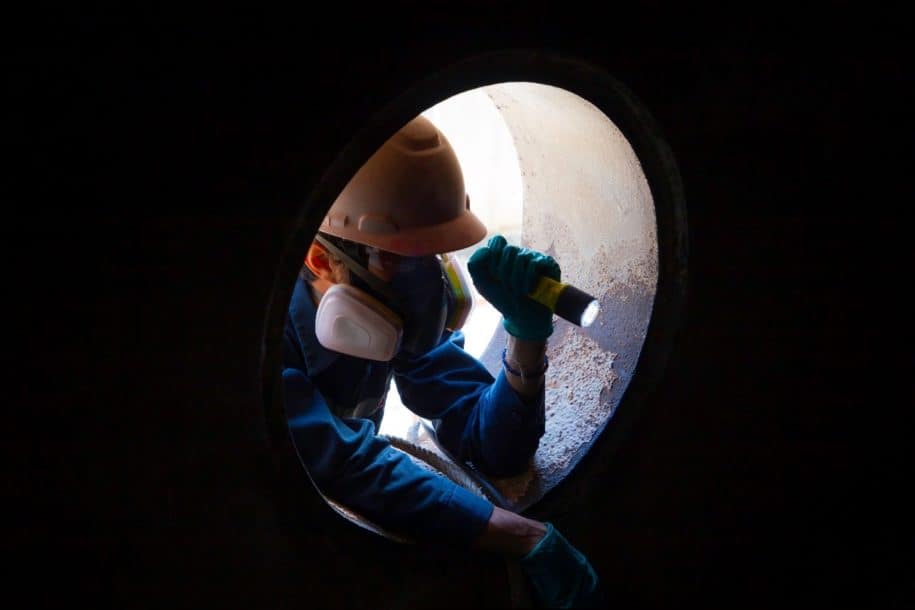Confined spaces can be found in many different types of workplaces, facilities, and locations. But what exactly is a confined space? According to the Occupational Health and Safety Administration (OSHA), a workspace is designated a confined space if all the following can be applied to it:
- There is room enough for entry to perform work.
- There are minimal or restricted means for going in and out of the space.
- The design of the space was not intended for occupancy.
All three of these conditions must be present for the space to be classified as a confined space. In other words, the space is not designed for someone to work in despite them being able to enter and operate inside it (e.g., pits, tanks, crawl spaces, grain bins, manholes, below-grade vaults, and tunnels). As with any other area, confined spaces can require repairs, inspections, and maintenance, but extra precautions should be taken in these cases.
Often, hazardous conditions are inherent to these spaces due to the presence of:
- Limited ventilation.
- An environment with a deficient or enriched oxygen supply.
- Toxic contamination.
- Flammable vapors.
- The potential for engulfment.
- Electrical and/or mechanical equipment.
- Numerous other potential environmental and/or safety issues.
When a confined space contains one or more of these hazards, the space is considered a “permit-required confined space” or PRCS. It is critical that workers fully understand the hazards that are present before entering a PRCS. OSHA has estimated that over 100 U.S. workers die each year in confined space accidents, and that more than 60% of those deaths are individuals attempting to rescue someone else. To address these dangers, OSHA’s confined space regulation 1910.146 requires employers to follow certain practices and procedures when there is a possible confined space on a worksite. The employer must:
- Survey the entire facility to determine if “confined spaces” or “permit-required confined spaces” exist on-site.
- If applicable, develop a written Permit-Required Confined Space Program, outlining how potential permit-required confined space hazards will be controlled (including measures for employee protection). The program should also include a complete hazard analysis and permit plan for each permit space in the workplace.
- Issue a Confined Space Entry Permit before any employees are allowed entry. This permit confirms that all steps have been taken to make the space safe for entry, that employees have been given all appropriate personal protection equipment (PPE) for their protection, and details the assignments for all Authorized Entrants, Authorized Attendants, and Entry Supervisors.
- Provide training for any employees required to work in permit-required confined spaces so that hazards and protection measures are known and understood.
If your workplace contains confined spaces, especially permit-required confined spaces, it is crucial to follow OSHA’s requirements to keep workers safe. EH&S software can help you comply with OSHA’s confined space regulations in a simple and organized manner.
EH&S software can:
- Track confined space inventory, locations, and permit requirements.
- List the known hazards of each confined space.
- Track air quality and testing information (atmospheric hazards).
- Store and organize confined space locations, photos, and information all in one central location.
- Track all permit requirements.
- Document permit approvals.
- List each worker and their assigned role during the entry process.
- Generate and store canceled permits.
- Identify what PPE and other supplies/materials are needed for safe entry.
- Store training information.
EH&S software assists with the administration, documentation, tracking, and storage of confined space permits—all without generating a pile of paperwork. Training modules can be used to assign confined space training and automatically send reminder notifications to employees when they are due for training. EH&S software can also help companies stay on top of medical surveillance compliance (such as annual fit tests) that may be required for worker respiratory protection when entering a confined space.
The confined space permitting process is necessary for keeping workers safe. There are too great of risks that come from missing a step when making sure employees are safely working in a confined space. Using EH&S software to comply with OSHA’s confined space regulation will save time, ensure every aspect of the regulation is met, and greatly reduce the probability of an accident.
Author Bio
The SafetyStratus Research Advisory Group (RAG) brings together thought leaders from the global environmental, health, and safety community to promote best practices and provide key insights in the profession and the industries they serve. The Research Advisory Group also advocates, where practical, the intersection of and advances with the use of technology, such as the SafetyStratus enterprise EHS software platform. Group membership consists of representatives from across varied disciplines and market sectors as well as select members of the SafetyStratus team.
The primary objectives of the SafetyStratus RAG partnership are to:
- Build a strategic partnership between EHS practitioners and the SafetyStratus team.
- Provide engaging and practical content to the global EHS community.
- Provide discipline and market feedback specific to SafetyStratus products and services.
While the objectives of the RAG are varied, the primary public-facing outcome will be available through engaging and practical content found on the SafetyStratus resource pages. Various articles, papers, and other valuable resources will be produced and shared as part of an ongoing effort to cultivate a robust community. Ultimately, the SafetyStratus RAG will expand to have a broader reach and provide opportunities for more inclusion by all interested EHS professionals in a collaborative community environment.
